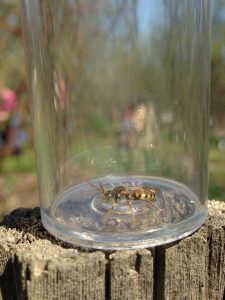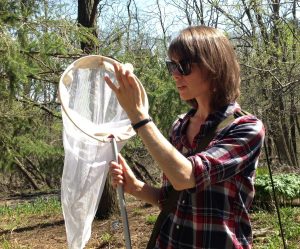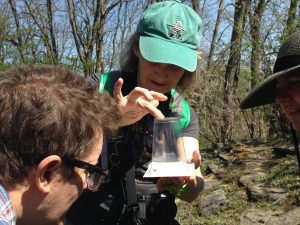by Lynn Ovenden, photos by Renate Sander-Regier
Bees are big this year. On May 12, the Wild Pollinator Partners network, led by Sandy Garland and Renate Sander-Regier, hosted a workshop on bees at the Fletcher Wildlife Garden with Dr. Jessica Forrest of Ottawa U. It was a standing room only crowd of over 25 people.
We learned that bees (like thrips) are the only organisms that can digest pollen grains. They have specialized pollen-carrying structures on their legs and abdomens.
Dr. Forrest showed us several other ways to distinguish bees from wasps and look-alike flies. She reviewed the main families of bees in the Ottawa region, their life cycles, where they nest, where to look for them, and how you get to be queen… or male… or worker. Question after question led the discussion into fascinating aspects of bees’ relationships with pollen, with flower types, bees’ foraging strategies (bottom of plant to top), and interactions with other kinds of bees.
Realizing that time was passing, we hurried outside to the Backyard Garden in search of bees and flowers. On this early spring day, only Barren Strawberry, Prairie Smoke, Marsh Marigold, and currant bushes were in bloom. We found bees at all four, although most were tiny and seldom still long enough to photograph.
We had more time to see the bees that Professor Forrest caught with a swoosh of her butterfly net, and then placed in plastic vials to pass around. The large bed of bright yellow Barren Strawberry flowers yielded a male Andrenid bee, a tiny dark-green carpenter bee (Ceratina), a small Halictid (Lasioglossum), and a brilliant green Halictid (either Augochlora or Agapostemon). A larger Halictid (Halictus) was found on the Prairie Smoke. [Thanks, Jessica, for identifying these to genus.]

Identifying bees in the field can be difficult when they are this tiny. This container is a plastic vial about an inch in diameter, and that’s a Nomada bee.
Toward the end of the afternoon, we talked about concern for the numbers of pollinators and of honey bees in particular. Agricultural demand for pollinators has increased over the past 20 years and the number of honeybee hives has gradually grown in Canada and worldwide.
Whether or not native bee populations have declined is the object of widespread interest, but there are insufficient data to be sure. A few species of bumble bee, once common, are now almost extinct, and habitat loss is likely a problem for many species. Gardens with some bare ground and various native plants that bloom from spring to fall can surely help.
Lynn Ovenden is a regular volunteer at the Fletcher Wildlife Garden. Her thoughtful enthusiasm for the natural world continually inspire us to pay more attention to our outdoor surroundings.

